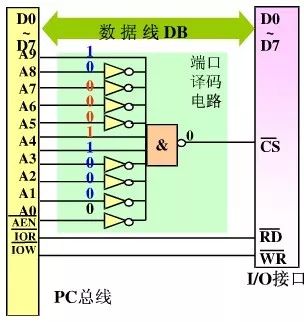The I/O port is a register in the interface circuit that can be directly accessed by the CPU. The access port is the register in the access interface circuit. An interface circuit (peripheral) usually has more than one port, such as a command port, a status port, a data port, and the like. The port address coding form has two modes: unified programming and independent programming. Commonly used is the independent programming form, that is, the peripheral port address is uniformly addressed together with different memory addresses. It is equipped with a special I/O instruction: IN/OUT (moving from the mov instruction of the memory). Port address decoding means identifying the port (interface/device) based on the address. Example: Analysis of the decoding circuit with the design port 218H: If the interface circuit selects the 218H address, the address bus input 218H should input a valid low level, while the other inputs generate an invalid high level.

The gate circuit is implemented as follows:

When the address signal is given to 218, CS is valid (chip select signal, active low); otherwise CS is inactive (high).
Strong and durable
Aluminum alloy plug, TPE cover
Hidden design
One second stretch, free storageUltrasonic welding pressure
Close fitting, firm resistance to fall
Strong and durable
Priority TPE
It's hard to break even if you stretch multiple times
Stretching or shrinking only one end can easily to damage the components and cause jamming
No winding
Stretch when used, shrink when not used
Five lengths
Each pause is a length, suitable for multiple occasions
Notice
Both cables are stretched at the same time
Do not stretch unilaterally
Data Cable Wiring,Original Data Cable,Computer Transfer Cable,Line Data Charging Cable
Guangzhou HangDeng Tech Co. Ltd , https://www.hangdengtech.com
